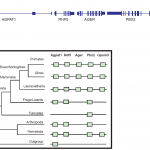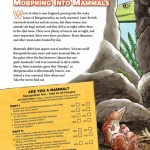mammal
A special thank you to reader Dr. Barbara Goodman, Professor of Physiology at Sanford School of Medicine of the University of South Dakota who sent me a story from The Scientist about sleep in animals complete with footage of a dolphin that was seen apparently "sleeping" (video posted on YouTube):
Why do animals sleep? This is a question with many potential answers. It is known that birds and mammals experience slow-wave and rapid eye movement (REM) sleep patterns. During the first pattern, slow waves with high amplitudes can be seen if measuring electrical…
Figure 1 showing RAGE (aka: Ager) expression only in mammals from Sessa et al., PLOS ONE. 9(1): e86903, 2014.
RAGE stands for "receptor for advanced glycation end-products", also known as "AGER", and new research shows that it first appeared in mammals (Sessa et al., 2014). Despite the name, the receptor also binds other signaling molecules such as HMGB1, S100 proteins, beta-amyloid, phosphatidylserine, among others (Xie et al., 2013). RAGE is reportedly involved in diabetes, cardiovascular disease, atherosclerosis, osteoarthritis, cancer, Alzheimer's disease, as well as liver and renal…
This was just too cute (and funny!) not to share. I came across a blog in Scientific American that discussed a "standardized test" created by Hannah Bonner, illustrator and children's writer, to help determine whether someone (or some creature) is a mammal:
Excerpt from "When Dinos Dawned, Mammals Got Munched, and Pterosaurs Took Flight"
The test is part of her book called "When Dinos Dawned, Mammals Got Munched, and Pterosaurs Took Flight." What a great educational tool. It is published by National Geographic Children's Books. Kudos to you Hannah!
Source:
Scientific American
Meet the first newly discovered mammalian species in 35 years, the olinguito, as presented by Rob Nelson from Untamed Science:
A collared brown lemur (Eulemur collaris) baby, photographed at the Bronx Zoo.
A golden-mantled ground squirrel (Spermophilus lateralis), photographed in Bryce Canyon National Park, Utah. Though abundant at the Samwell Cave Popcorn Dome, California site during the Late Pleistocene, its numbers in the area decline at the beginning of the present Holocene epoch.
"One of the penalties of an ecological education", the naturalist Aldo Leopold once wrote, "is that one lives alone in a world of wounds." Few knew this better than he did. Despite becoming a celebrated advocate of wilderness for its own sake during the early twentieth century, Leopold began his career by…
"Dinah", a young female gorilla kept at the Bronx Zoo in 1914. From the Zoological Society Bulletin.
Frustrated by the failure of gorillas to thrive in captivity, in 1914 the Bronx Zoo's director William Hornaday lamented "There is not the slightest reason to hope that an adult gorilla, either male or female, ever will be seen living in a zoological park or garden." Whereas wild adult gorillas were "savage" and "implacable" beasts which could not be captured (a photo of a sculpture included in Hornaday's article depicts a gorilla strangling one man, brandishing another about with its other…
A female pronghorn (Antilocapra americana), photographed at Bryce Canyon National Park, Utah.
Mule deer (Odocoileus hemionus), photographed at Bryce Canyon National Park, Utah.
A Utah prairie dog (Cynomys parvidens), photographed in Bryce Canyon National Park, Utah.
A young lowland gorilla (Gorilla gorilla), photographed at the Bronx Zoo.
An ebony langur (Trachypithecus auratus), photographed at the Bronx Zoo.
A young California sea lion (Zalophus californianus), photographed at the Bronx Zoo.
A huon tree kangaroo (Dendrolagus matschiei), photographed at the Bronx Zoo.
Zeff the Amur tiger (Panthera tigris altaica), photographed at the Bronx Zoo.
Close up of one of the Pipe Creek Sinkhole coprolites showing structures interpreted as hair (A) and a close-up of a mold in the coprolite thought to have been made by a hair (B). From Farlow et al, 2010.
Time and again I have stressed that every fossil bone tells a story, and, in a different way, so do coprolites. They are small snapshots of a moment in the life of an organism, often preserving bits of their meals, and while they may not get top billing in museum halls, they are among the most pungent reminders that weird and wonderful organisms really did live during the remote past. As…

